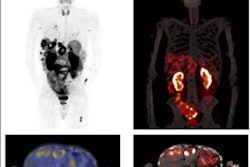
PHILADELPHIA - A PET image that shows the combined power of the diagnostic and therapeutic (theranostic) use of molecular imaging to identify and treat metastatic castration-resistant prostate cancer has been named this year's Image of the Year at the Society of Nuclear Medicine and Molecular Imaging (SNMMI) annual meeting.
The image demonstrates the theranostic combination of a PET diagnostic radiotracer consisting of gallium-68 (Ga-68) prostate-specific membrane antigen (PSMA11) that shows the progress of treatment administered with another radiopharmaceutical, lutetium-177 PSMA617 (LuPSMA). LuPSMA is a radiolabeled small molecule that binds with high affinity to PSMA in men with castration-resistant prostate cancer and delivers a therapeutic dose of radiation to prostate cancer cells.
The award-winning image came from a phase II prospective study at the Peter MacCallum Cancer Centre in Melbourne and shows that men with castration-resistant prostate cancer can be treated successfully with LuPSMA as an alternative to external-beam radiation therapy.
"This work reflects an appreciation for all the basic science and translation work that has been performed by many groups over a long period of time to develop prostate-specific membrane antigen theranostics as a paradigm-changing practice for improving patient outcomes," said lead study author Dr. Michael Hofman.
The study included 30 patients with PSMA-avid metastatic castration-resistant prostate cancer who did not respond to standard therapies. Patients were included if they had high uptake on Ga-68-PSMA11 PET/CT scans, which were defined by images with maximum standardized uptake values (SUVmax) of greater than 1.5 times that of the liver. Subjects were excluded if FDG-PET/CT scans showed sites of PSMA-negative disease.
Patients with high PSMA expression went on to undergo as many as four cycles of LuPSMA therapy every six weeks. The high response rates then were visible in the PET images.
 Ga-68-PSMA-11 images were acquired before and after lutetium-177 PSMA617 treatment in eight patients with metastatic prostate cancer who had exhausted standard therapeutic options. PET maximum intensity projection (MIP) images indicate PSA decline of 98% or greater. Disease is identified in red areas, indicating standardized uptake values higher than 3. Images courtesy of Hofman et al, Peter MacCallum Cancer Centre in Melbourne, Australia, and SNMMI.
Ga-68-PSMA-11 images were acquired before and after lutetium-177 PSMA617 treatment in eight patients with metastatic prostate cancer who had exhausted standard therapeutic options. PET maximum intensity projection (MIP) images indicate PSA decline of 98% or greater. Disease is identified in red areas, indicating standardized uptake values higher than 3. Images courtesy of Hofman et al, Peter MacCallum Cancer Centre in Melbourne, Australia, and SNMMI.The primary end point of LuPSMA treatment -- PSA decline of 50% or greater -- was achieved by 17 patients (57%). That total included 11 men (37%) with a PSA decline of 80% or more. In addition, median PSA progression-free survival was 7.6 months, while median overall survival was 13.5 months.
"In each patient, the extent of tumor spread before and after treatment is visualized with clarity using PSMA PET," Hofman said. "These patients experienced improved quality of life, including reduction of pain, and correlated with marked reduction of prostate specific antigen."
SNMMI annually chooses an image that exemplifies the most promising advances in the field of nuclear medicine and molecular imaging. This year's SNMMI Henry N. Wagner Jr. Image of the Year was chosen from more than 2,200 abstracts submitted to the annual meeting and voted on by reviewers and the society leadership.
"The last decade has seen a blossoming of theranostics to treat tumors with molecularly guided radiotherapy," said Dr. Umar Mahmood, PhD, chair of the SNMMI Scientific Program Committee. "The expansion of patients benefiting from this approach is remarkable, and it is wonderful to know that this effort is being led by nuclear medicine physicians and scientists."
Hofman also thanked the Australian Nuclear Science and Technology Organization (ANSTO), which produces lutetium-177, and Endocyte, which produces LuPSMA, for making the study possible.




















